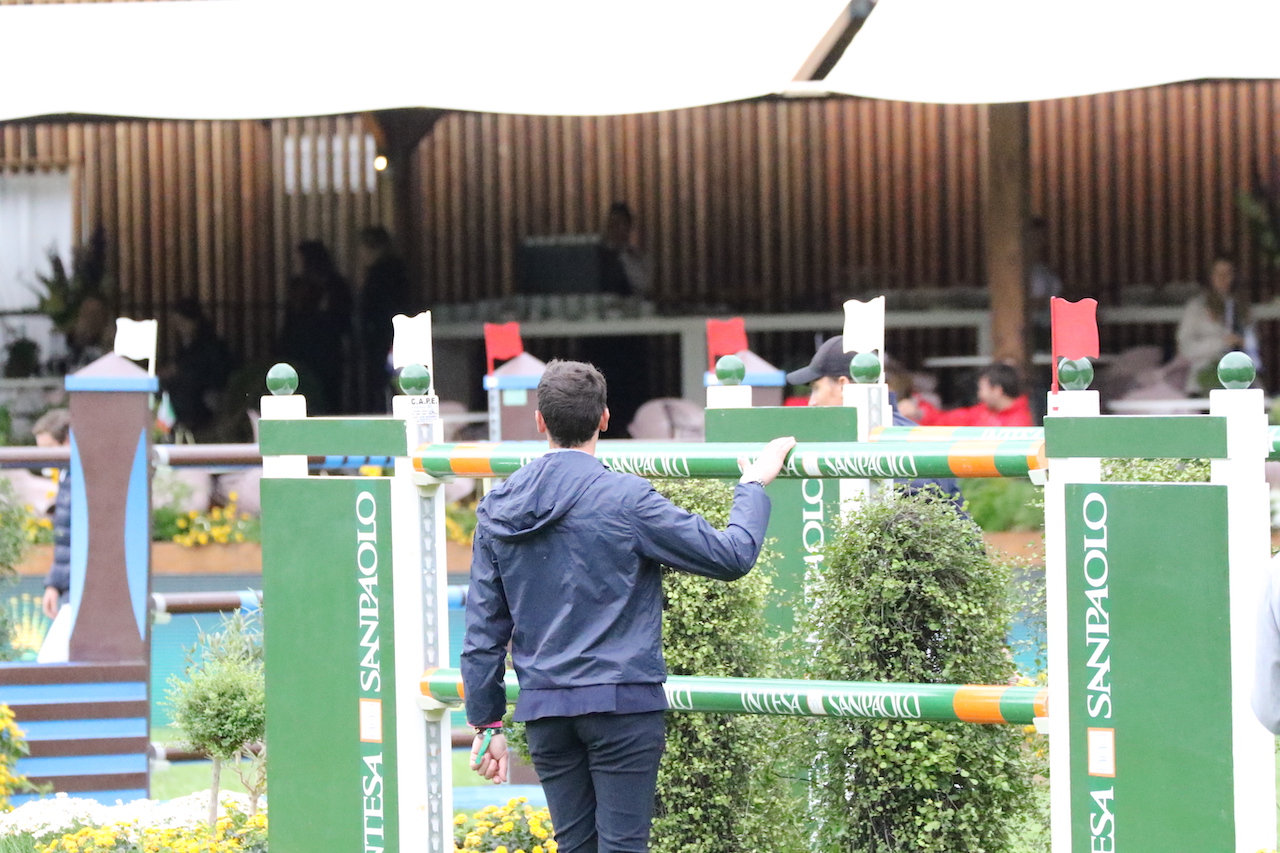As the FEI celebrates its centenary this year, some of the biggest names in modern course design talk about the changes and challenges in the sports of Jumping and Eventing. They may have their very different styles and their own personal opinions, but they are all agreed on one thing. Their job is all about what is best for the horse….
Spain’s Santiago Varela had just returned from the hugely successful CHIO Rotterdam in The Netherlands and was turning his focus to the rescheduled Tokyo 2020 Olympic Games. It’s a busy time for the man whose life is divided between his job as CEO of a company involved in the renewable energy sector and building tracks for the best Jumping horses and athletes in the world.
“I will fly to Tokyo on 21 July and arrive on the 22nd and will start work immediately”, he says. “The 1st of August is the Jumping phase of Eventing and the last day I will build will be 7 August. So in one month I’ll be free, and the happiest man in the world because I will have fulfilled a dream!”.
He made his name in the course design business through his connection with Madrid Horse Show where he was Assistant Course Designer until 1998. He should have taken over the Official role that year “but my wife had other ideas! We got married during the show and on the day of the wedding I worked in the arena until 3pm and then rushed home to change and go to the church. So for that year I had to remain as the Assistant!”.
He competed himself during his teenage years, and amongst his heroes was six-time Olympian Luis Alvarez Cervera. “Everyone came to the show in Madrid when I was young, the British team, Eddie Macken from Ireland and I remember Neco (Brazil’s Nelson Pessoa) too. All the horses he rode were the perfect ones because he made them perfect!”.
Philosophy
His philosophy for course design is simple. “The course always needs to be fair for the horses. The modern horse is very clever and they are super athletes, but they need to be protected so we must always build a course that they can jump well.”
He says good design is all about keeping the horse’s canter. “It is fundamental, it’s the only way to play with the balance of the horse. Arno Gego (legendary German course designer) defined it well - ‘you find your line and the horses need to flow’. It’s only when you understand that then you can progress to becoming a top course designer. If you don’t allow horses to keep their canter and rhythm and flow through the course then they cannot jump the big fences”, he explains.
And he reveals one secret. “The fences are only a relative issue, not a definitive issue. Distances are only numbers, and numbers alone don’t mean anything. A distance in a combination looks short or long depending on what happened before you arrived there. The riders need to interpret the course because it is a different test for every horse. They need to adjust their plan for a smaller or slower horse with a shorter or longer stride, but one thing they all have in common is that they need to keep the canter and keep the balance.”
So is it difficult for the course designer to find his own balance when, for instance, setting a track for the Olympic Games where riders with many different levels of experience will compete?
“No, it is exactly the same when you are building for a World Cup Final or European Championship or World Equestrian Games, you present the same course for the rider ranked 1,000 and the rider ranked number one and everyone in between. At the Nations Cup Final in Barcelona we have 19 teams, and not all of them are Germany!”, he quips, referring to the strength in depth of Germany in the sport.
“Everyone who competes has achieved a high enough level to be there and it is in the nature of the sport that the best will come out on top. The course is the same for everyone, from first to last.”
So his expectations for how things will play out in Tokyo? “We know about the heat and humidity and have to take that into account. I built a course for Eventing riders at the Test Event and saw the venue being developed and it is truly unbelievable. I’ve been to Tokyo four times now and Baji Koen is a fantastic venue and the conditions for the horses are excellent”, he says.
Impression
Alan Wade was speaking from Tryon, North Carolina (USA), the venue where he made such a huge impression with his brilliant Jumping courses for the FEI World Equestrian Games™ 2018. The Irishman’s design-style is different to Varela’s, but his principles are much the same.
“Course design has improved immensely, and nowadays everything we do has the safety of the horse at the forefront. I make courses that are fair for the horse and testing for the riders”, he says.
He cut his course design teeth in the green fields of South-East Ireland, in particular at Holycross Show in Tipperary where his legendary father, the late great Tommy Wade, presented some of the most challenging tracks on the Irish circuit. And, like his dad, Alan builds courses that are not for the faint-hearted.
“When I started out there were no safety cups, the poles were heavy and a lot of the fences were filled in. Maybe you needed a braver horse back then, but the sport has moved on. Personally I’m still looking for that boldness, using trees or nice fillers but still looking for carefulness.”
Quality horsemen
He says it was easy for him to learn his trade because he had such quality horsemen competing over his tracks. “Francis Connors and Shane Breen - two of the best riders Ireland has ever produced - they weren’t shy about fillers and they set a standard that raised the bar for everyone else”. Great Britain’s David Broome was one of his childhood heroes. “Everything looked so smooth and if adjustment was needed it was done early. Against the clock he never seemed to be going flat out and he always had the horse balanced. The top riders make it look easy.”
He particularly enjoys building at Dublin Horse Show because he’s free to use fence material of his own choosing. “In some parts of the world you can have 50% sponsor fences and sometimes the same fences are sent from competition to competition and it’s the same visual test for a lot of the horses. I like to mix it up a bit.
“All top courses should have different tests all around the course, parts that might suit a smaller horse or one with a longer stride. The overall test should be a mixture of a whole lot of different tests, so when the rider walks the course he needs to work out what will and won’t suit his particular horse at various points around the track.”
And what about building Championship courses for riders with a range of experience? “It’s nearly easier to build a 5* track because 5* riders know what to expect. But when you’ve got 10 to 15 really good combinations, then a bunch of middling ones and 10 to 15 that are stepping up in the sport then that’s where I feel your judgement has to be just right if you are going to have good sport and a proper winner. That is the real test of the skill-set of a course designer.”.
Both sides
Eventing course designer, America’s Derek di Grazia, was speaking from his home in California, USA. It was 9 July, and he had just returned from his last pre-Games check in Tokyo. This is a man who knows his sport from both sides of fence. “I’ve always been a rider and still am to this day”, he says.
He started out doing design work in the 1980s, built his first track at Essex in New Jersey (USA) in the early 1990s, “and my first big break was at Fairhill (USA) in 1999 where I’ve been involved for 21 years!” Over the years he’s had a long association with many other high-profile events including Bromont in Canada and the Kentucky 5* since 2011.
Tokyo 2020 is his first Olympic contract. “Everyone wants to build at an Olympic Games and it’s probably always going to be a situation where you are presented with a new site and you have to develop it.
“It’s been a big project and we are into our fifth year now. From the beginning I knew it would be a challenge. The site was just a big open piece of ground with a lot of trees on it.”
But it’s not just about plotting a course and placing fences on it. “I don’t think people realise how much planning and thought goes into the infrastructure too. There’s a huge list of things to be put in place - stabling for the horses who will spend one night there, veterinary facilities, cooling areas, broadcast facilities, the list goes on and on.”
He says his biggest task was making the distance fit onto the piece of land he was presented with, and then finding a spot for everything else. “Sea Forest is basically an island with water all around and great views of the city. The transformation from the beginning to now is quite amazing. We are just doing the final preparations at the moment and I’ve been working with fence builder David Evans. This is his third Olympic Games.”
All-rounders
It seems Eventing course designers are indeed all-rounders. Great Britain’s Mike Etherington-Smith has been a horse producer and competitor, a Technical Delegate, an event organiser, an administrator and one of the most sought-after creators of top Cross Country tracks of the modern era. In recent years he moved into the racing world, taking up the role of Equine Safety Advisor for the Horse Welfare Board, but he is still involved in course design and enjoys every moment of it.
Reflecting on the principles he applies to his design work he says that when he builds a fence he always asks himself if he would be prepared to jump it. “We have to be fair to horses while testing the rider’s ability over different terrain so that they show their skills, competence and ability to prepare and to compete well.
“We don’t have to be smart as course designers, we don’t need to over-complicate things. You put your test out there so that horses learn and grow from the experience of tackling it. No tricks, and no surprises…..fences need definition and contrast so the horse knows exactly what it is being asked to do”.
He says Eventing horses have not changed a lot down the years, but the sport is making different demands on them. “They still have to be athletic and nimble, but today’s courses are more intense and more technical because big, bold fences stopped being good enough to sort them out.”
Source: FEI

